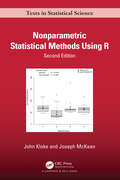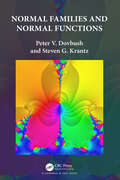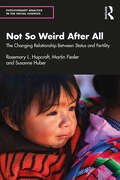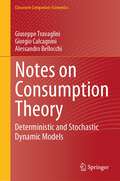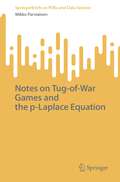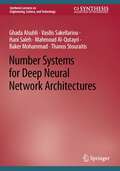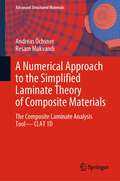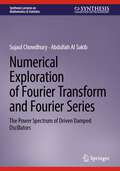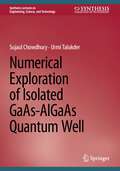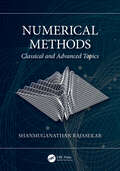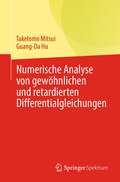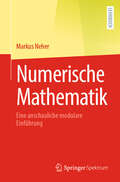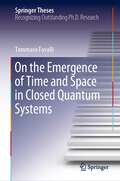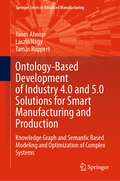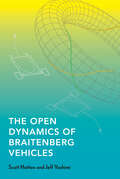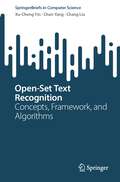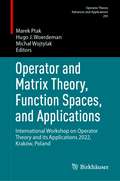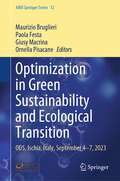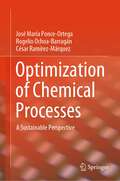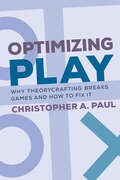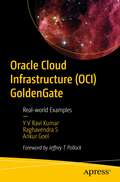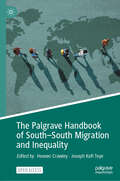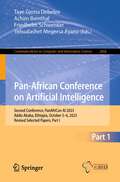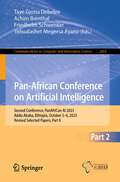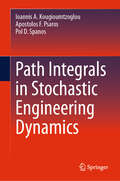- Table View
- List View
Nonparametric Statistical Methods Using R (Chapman & Hall/CRC Texts in Statistical Science #25)
by John Kloke Joseph McKeanPraise for the first edition:“This book would be especially good for the shelf of anyone who already knows nonparametrics, but wants a reference for how to apply those techniques in R.”-The American StatisticianThis thoroughly updated and expanded second edition of Nonparametric Statistical Methods Using R covers traditional nonparametric methods and rank-based analyses. Two new chapters covering multivariate analyses and big data have been added. Core classical nonparametrics chapters on one- and two-sample problems have been expanded to include discussions on ties as well as power and sample size determination. Common machine learning topics --- including k-nearest neighbors and trees --- have also been included in this new edition.Key Features: Covers a wide range of models including location, linear regression, ANOVA-type, mixed models for cluster correlated data, nonlinear, and GEE-type. Includes robust methods for linear model analyses, big data, time-to-event analyses, timeseries, and multivariate. Numerous examples illustrate the methods and their computation. R packages are available for computation and datasets. Contains two completely new chapters on big data and multivariate analysis. The book is suitable for advanced undergraduate and graduate students in statistics and data science, and students of other majors with a solid background in statistical methods including regression and ANOVA. It will also be of use to researchers working with nonparametric and rank-based methods in practice.
Normal Families and Normal Functions
by Peter V. Dovbush Steven G. KrantzThis book centers on normal families of holomorphic and meromorphic functions and also normal functions. The authors treat one complex variable, several complex variables, and infinitely many complex variables (i.e., Hilbert space).The theory of normal families is more than 100 years old. It has played a seminal role in the function theory of complex variables. It was used in the first rigorous proof of the Riemann mapping theorem. It is used to study automorphism groups of domains, geometric analysis, and partial differential equations.The theory of normal families led to the idea, in 1957, of normal functions as developed by Lehto and Virtanen. This is the natural class of functions for treating the Lindelof principle. The latter is a key idea in the boundary behavior of holomorphic functions.This book treats normal families, normal functions, the Lindelof principle, and other related ideas. Both the analytic and the geometric approaches to the subject area are offered. The authors include many incisive examples.The book could be used as the text for a graduate research seminar. It would also be useful reading for established researchers and for budding complex analysts.
Not So Weird After All: The Changing Relationship Between Status and Fertility (Evolutionary Analysis in the Social Sciences)
by Rosemary L. Hopcroft Martin Fieder Susanne HuberThis is the first book to fully examine, from an evolutionary point of view, the association of social status and fertility in human societies before, during, and after the demographic transition. In most nonhuman social species, social status or relative rank in a social group is positively associated with the number of offspring, with high-status individuals typically having more offspring than low-status individuals. However, humans appear to be different. As societies have gotten richer, fertility has dipped to unprecedented lows, with some developed societies now at or below replacement fertility. Within rich societies, women in higher-income families often have fewer children than women in lower-income families. Evolutionary theory suggests that the relationship between social status and fertility is likely to be somewhat different for men and women, so it is important to examine this relationship for men and women separately. When this is done, the positive association between individual social status and fertility is often clear in less-developed, pre-transitional societies, particularly for men. Once the demographic transition begins, it is elite families, particularly the women of elite families, who lead the way in fertility decline. Post-transition, the evidence from a variety of developed societies in Europe, North America and East Asia is that high-status men (particularly men with high personal income) do have more children on average than lower-status men. The reverse is often true of women, although there is evidence that this is changing in Nordic countries. The implications of these observations for evolutionary theory are also discussed. This book will be of interest to students and researchers in the social sciences with an interest in evolutionary sociology, evolutionary anthropology, evolutionary psychology, demography, and fertility.
Notes on Consumption Theory: Deterministic and Stochastic Dynamic Models (Classroom Companion: Economics)
by Giuseppe Travaglini Giorgio Calcagnini Alessandro BellocchiThis textbook offers a compact, yet formal, synthesis of the broad field of consumption theory. Written in a coherent and accessible way, this book introduces graduate and postgraduate students to dynamic optimization applied to consumption under certainty and uncertainty, in discrete and continuous time. Delving into deterministic and stochastic models, including the use of Brownian motions, the book offers a deeper understanding of consumption decisions and their impact on asset pricing and investment in partial and general equilibrium. This book compiles lecture notes from advanced courses in micro- and macroeconomics, ensuring a self-contained introduction to the subject. Balancing simplicity with analytical rigor, the book equips readers with essential methodological tools for advanced research in economics. With empirical evidence and exercises integrated throughout, this textbook stands as the go-to resource for scholars and students alike, fostering further theoretical explorations in the field. Basic knowledge of economics, mathematics, and econometrics is recommended for a comprehensive understanding.
Notes on Tug-of-War Games and the p-Laplace Equation (SpringerBriefs on PDEs and Data Science)
by Mikko ParviainenThis book addresses the interplay between stochastic processes and partial differential equations. More specifically, it focuses on the connection between the nonlinear p-Laplace equation and the stochastic game called tug-of-war with noise. The connection in this context was discovered approximately 15 years ago and has since provided new insights and approaches. These lecture notes provide a brief but detailed and accessible introduction to the subject and to the more research-oriented literature. The book also presents the parabolic case side by side with the elliptic case, highlighting the fact that elliptic and parabolic equations are close in spirit in certain aspects. Moreover, it covers some parts of the regularity theory for these problems. Graduate students and advanced undergraduate students with a basic understanding of probability and partial differential equations will find this book useful.
Number Systems for Deep Neural Network Architectures (Synthesis Lectures on Engineering, Science, and Technology)
by Ghada Alsuhli Vasilis Sakellariou Hani Saleh Mahmoud Al-Qutayri Baker Mohammad Thanos StouraitisThis book provides readers a comprehensive introduction to alternative number systems for more efficient representations of Deep Neural Network (DNN) data. Various number systems (conventional/unconventional) exploited for DNNs are discussed, including Floating Point (FP), Fixed Point (FXP), Logarithmic Number System (LNS), Residue Number System (RNS), Block Floating Point Number System (BFP), Dynamic Fixed-Point Number System (DFXP) and Posit Number System (PNS). The authors explore the impact of these number systems on the performance and hardware design of DNNs, highlighting the challenges associated with each number system and various solutions that are proposed for addressing them.
A Numerical Approach to the Simplified Laminate Theory of Composite Materials: The Composite Laminate Analysis Tool—CLAT 1D (Advanced Structured Materials #202)
by Andreas Öchsner Resam MakvandiA typical approach to treat composite materials, which are composed of layered unidirectional lamina, is the so-called classical laminate theory (CLT). This theory is based on the theory for plane elasticity elements and classical (shear-rigid) plate elements under the assumption of orthotropic constitutive equations. The solution of the fundamental equations of the classical laminate theory is connected with extensive matrix operations and many problems require in addition iteration loops.This two-dimensional approach and the underlying advanced continuum mechanical modeling might be very challenging for some students, particularly at universities of applied sciences. Thus, a reduced approach, the so-called simplified classical laminate theory (SCLT), has been recently proposed. The idea was to use solely isotropic one-dimensional elements, i.e., a superposition of bar and beam elements, to introduce the major calculation steps of the classical laminate theory. Understanding this simplified theory is much easier and the final step it to highlight the differences when moving to the general two-dimensional case.This monograph first provides a systematic and thorough introduction to the simplified laminate theory based on the theory for bars and classical beam plate elements. The focus is on stacking of isotropic layers to simplified laminates. In addition to the elastic behavior, failure is investigated based on the maximum stress, maximum strain, Tsai-Hill, and the Tsai-Wu criteria. We provide a Python-based computational tool, the so-called Composite Laminate Analysis Tool (CLAT 1D) to easily solve some standard questions from the context of fiber reinforced composites. The tool runs in any standard web browser and offers a user-friendly interface with many post-processing options. The functionality comprises stress and strain analysis of simplified lamina and laminates and the failure analysis based on different criteria.
Numerical Exploration of Fourier Transform and Fourier Series: The Power Spectrum of Driven Damped Oscillators (Synthesis Lectures on Mathematics & Statistics)
by Sujaul Chowdhury Abdullah Al SakibThis book presents practical demonstrations of numerically calculating or obtaining Fourier Transform. In particular, the authors demonstrate how to obtain frequencies that are present in numerical data and utilizes Mathematica to illustrate the calculations. This book also contains numerical solution of differential equation of driven damped oscillator using 4th order Runge-Kutta method. Numerical solutions are compared with analytical solutions, and the behaviors of mechanical system are also depicted by plotting velocity versus displacement rather than displaying displacement as a function of time. This book is useful to physical science and engineering professionals who often need to obtain frequencies present in numerical data using the discrete Fourier transform.This book: Aids readers to numerically calculate or obtain frequencies that are present in numerical dataExplores the use of the discrete Fourier transform and demonstrates practical numerical calculationUtilizes 4th order Runge-Kutta method and Mathematica for the numerical solution of differential equation
Numerical Exploration of Isolated GaAs-AlGaAs Quantum Well (Synthesis Lectures on Engineering, Science, and Technology)
by Sujaul Chowdhury Urmi TalukderThis book begins with the eigenvalue equation of energy and presents calculation of the energy spectrum of GaAs-AlGaAs Quantum Well using finite difference method and knowledge of potential energy profile, without using expressions for eigenfunctions, continuity of eigenfunctions, or their spatial derivatives at the two abrupt potential steps. The authors find that the results are almost the same as those obtained by solving numerically using regula falsi method, and transcendental equations that are obeyed by the energy levels, where the transcendental equations are obtained by requiring continuity of eigenfunctions and of their spatial derivatives at the two potential steps. Thus, this book confirms that it is possible to numerically calculate the energy spectrum of Quantum Well by the finite difference method when it is not correct or when it is not possible to use continuity of eigenfunctions and their spatial derivatives at the two abrupt potential steps. The authors also showthat it is possible to use the finite difference method in cases where the potential steps are non-abrupt. The book demonstrates this by calculating the energy spectrum of isolated parabolic Quantum Well of finite depth using finite difference method.
Numerical Methods: Classical and Advanced Topics
by Shanmuganathan RajasekarThis book presents a pedagogical treatment of a wide range of numerical methods to suit the needs of undergraduate and postgraduate students, and teachers and researchers in physics, mathematics, and engineering. For each method, the derivation of the formula/algorithm, error analysis, case studies, applications in science and engineering and the special features are covered. A detailed presentation of solving time-dependent Schrödinger equation and nonlinear wave equations, along with the Monte Carlo techniques (to mention a few) will aid in students’ understanding of several physical phenomena including tunnelling, elastic collision of nonlinear waves, electronic distribution in atoms, and diffusion of neutrons through simulation study.The book covers advanced topics such as symplectic integrators and random number generators for desired distributions and Monte Carlo techniques, which are usually overlooked in other numerical methods textbooks. Interesting updates on classical topics include: curve fitting to a sigmoid and Gaussian functions and product of certain two functions, solving of differential equations in the presence of noise, and solving the time-independent Schrödinger equation.Solutions are presented in the forms of tables and graphs to provide visual aid and encourage a deeper comprehension of the topic. The step-by-step computations presented for most of the problems can be verifiable using a scientific calculator and is therefore appropriate for classroom teaching. The readers of the book will benefit from acquiring an acquittance, knowledge, experience and realization of significance of the numerical methods covered, their applicability to physical and engineering problems and the advantages of applying numerical methods over theoretical methods for specific problems.
Numerische Analyse von gewöhnlichen und retardierten Differentialgleichungen
by Taketomo Mitsui Guang-Da HuDieses Buch dient als prägnantes Lehrbuch für Studenten in einem fortgeschrittenen Undergraduate- oder First-Year-Graduate-Kurs in verschiedenen Disziplinen wie angewandte Mathematik, Steuerung und Ingenieurwesen, die den modernen Standard der numerischen Methoden von gewöhnlichen und verzögerten Differentialgleichungen verstehen wollen. Experten in denselben Bereichen können sich auch über die jüngsten Entwicklungen in der numerischen Analyse solcher Differentialsysteme informieren. Gewöhnliche Differentialgleichungen (ODEs) sind ein starkes mathematisches Werkzeug, um eine Vielzahl von Phänomenen in Wissenschaft und Technik auszudrücken. Neben ihrer eigenen Bedeutung ist eine der mächtigen Richtungen, in die sich ODEs ausdehnen, die Einbeziehung einer unbekannten Funktion mit verzögertem Argument. Dies wird als verzögerte Differentialgleichungen (Delay differential equations, DDEs) bezeichnet, die häufig in der mathematischen Modellierung vonBiologie, Demographie, Epidemiologie und Kontrolltheorie vorkommen. In einigen Fällen kann die Lösung einer Differentialgleichung durch algebraische Kombinationen bekannter mathematischer Funktionen erhalten werden. In vielen praktischen Fällen ist eine solche Lösung jedoch recht schwierig oder nicht verfügbar, und es sind numerische Näherungen erforderlich. Die moderne Entwicklung von Computern beschleunigt die Situation und eröffnet darüber hinaus mehr Möglichkeiten der numerischen Mittel. Die Kenntnis und das Fachwissen über die numerische Lösung von Differentialgleichungen wird nun in weiten Bereichen der Wissenschaft und des Ingenieurwesens vorausgesetzt.Man könnte meinen, dass ein gut organisiertes Softwarepaket wie MATLAB in etwa die gleiche Lösung bietet. In gewisser Weise stimmt das auch, aber man muss bedenken, dass der blinde Einsatz von Softwarepaketen den Benutzer in die Irre führt. Das Wesentliche der numerischen Lösung von Differentialgleichungen muss noch gelernt werden. Das vorliegende Buch soll das Wesentliche der numerischen Lösungen von gewöhnlichen Differentialgleichungen sowie von Verzögerungsdifferentialgleichungen vermitteln. Die Autoren haben insbesondere festgestellt, dass es noch wenige prägnante Lehrbücher über Verzögerungsdifferentialgleichungen gibt, und haben sich dann daran gemacht, die Lücke durch möglichst transparente Beschreibungen zu schließen. Die wichtigsten Algorithmen zur numerischen Lösung sind in diesem Buch klar beschrieben. Auch die Stabilität von Lösungen von ODEs und DDEs ist von entscheidender Bedeutung. Das Buch führt in die asymptotische Stabilität von analytischen und numerischen Lösungen ein und bietet einen praktischen Weg zur Analyse ihrer Stabilität unter Verwendung einer Theorie komplexer Funktionen.
Numerische Mathematik: Eine anschauliche modulare Einführung
by Markus NeherDieses Lehrbuch bietet einen breit aufgestellten und dennoch kompakten Überblick zu den gängigen Verfahren der Numerik. Durch zahlreiche Beispiele und erläuternde Bemerkungen ist es besonders anschaulich und eignet sich auch – aber keinesfalls ausschließlich! – gut für Lehramtsstudierende.Behandelt werden numerische Verfahren zur Lösung linearer und nichtlinearer Gleichungssysteme, zur Eigenwertberechnung bei Matrizen, zur Approximation univariater Funktionen sowie zur näherungsweisen Integration bezüglich einer Veränderlichen. Ein einführendes erstes Kapitel schafft insbesondere das nötige Grundverständnis für die zentralen Begriffe Kondition und Stabilität, die aber erst im letzten Kapitel rigoros diskutiert werden um den Einstieg in die Numerik nicht durch aufwändige Stabilitätsanalysen zu erschweren.Die einzelnen Kapitel sind größtenteils unabhängig voneinander, teilweise können auch einzelne Abschnitte separat gelesen werden. Punktuelles Lernen und Nachschlagen ist damit problemlos möglich.
On the Emergence of Time and Space in Closed Quantum Systems (Springer Theses)
by Tommaso FavalliTime, space and entanglement are the main characters in this book. Their nature is still a great mystery in physics and we study here the possibility that these three phenomena are closely connected, showing how entanglement can be at the basis of the emergence of time and space within closed quantum systems. We revisit and extend the Page and Wootters theory that was originally introduced in order to describe the emergence of time through entanglement between subsystems in a globally static, quantum Universe. In the book, after providing a complete review of the salient aspects of the theory, we establish a connection with recent research on the foundations of statistical mechanics and we provide a new understanding of the thermalization process. Furthermore, we generalize the framework in order describe the spatial degree of freedom and we provide a model of 3+1 dimensional, quantum spacetime emerging from entanglement among different subsystems in a globally "timeless" and "positionless" Universe. Finally, via the Page and Wootters theory, the evolution of quantum clocks within a gravitational field is treated and a time dilation effect is obtained in agreement with the Schwarzschild solution.
Ontology-Based Development of Industry 4.0 and 5.0 Solutions for Smart Manufacturing and Production: Knowledge Graph and Semantic Based Modeling and Optimization of Complex Systems (Springer Series in Advanced Manufacturing)
by János Abonyi László Nagy Tamás RuppertThis book presents a comprehensive framework for developing Industry 4.0 and 5.0 solutions through the use of ontology modeling and graph-based optimization techniques. With effective information management being critical to successful manufacturing processes, this book emphasizes the importance of adequate modeling and systematic analysis of interacting elements in the era of smart manufacturing. The book provides an extensive overview of semantic technologies and their potential to integrate with existing industrial standards, planning, and execution systems to provide efficient data processing and analysis. It also investigates the design of Industry 5.0 solutions and the need for problem-specific descriptions of production processes, operator skills and states, and sensor monitoring in intelligent spaces. The book proposes that ontology-based data can efficiently represent enterprise and manufacturing datasets. The book is divided into two parts: modeling and optimization. The semantic modeling part provides an overview of ontologies and knowledge graphs that can be used to create Industry 4.0 and 5.0 applications, with two detailed applications presented on a reproducible industrial case study. The optimization part of the book focuses on network science-based process optimization and presents various detailed applications, such as graph-based analytics, assembly line balancing, and community detection. The book is based on six key points: the need for horizontal and vertical integration in modern industry; the potential benefits of integrating semantic technologies into ERP and MES systems; the importance of optimization methods in Industry 4.0 and 5.0 concepts; the need to process large amounts of data while ensuring interoperability and re-usability factors; the potential for digital twin models to model smart factories, including big data access; and the need to integrate human factors in CPSs and provide adequate methods to facilitate collaboration and support shop floor workers.
The Open Dynamics of Braitenberg Vehicles
by Jeff Yoshimi Scott HottonAn introduction to dynamical systems theory, a detailed mathematical analysis of pairs of Braitenberg vehicles, and a look at how these results apply to the study of physical and biological organisms.Powering the concept of a Braitenberg vehicle, developed in 1984 by the Italian-Austrian cyberneticist Valentino Braitenberg, is the idea that simple systems can produce complex behaviors. A pair of interacting Braitenberg vehicles is simple, but they can meander, wind around, and follow each another in a number of ways. In this book, Scott Hotton and Jeff Yoshimi show how dynamical systems theory—in particular the theory of open dynamic systems—can be used to analyze pairs of these vehicles in great detail. The result of the authors&’ long-standing collaboration at the intersection of mathematics, philosophy, cognitive science, and biology, The Open Dynamics of Braitenberg Vehicles offers a rigorous mathematical foundation for embodied cognition, especially when it comes to two-way interactions between an agent and its environment.Following an introduction to dynamical systems theory, and the most detailed mathematical analysis of Braitenberg vehicles to date, Hotton and Yoshimi discuss how their results can be applied to the study of physical and biological systems. They also describe their work's relevance to debates in the philosophy of embodied cognitive science. Combining the best features of embodied and representational approaches to cognitive science, complete with code and simulations, The Open Dynamics of Braitenberg Vehicles provides an extremely accessible and visually rich look into the workings and applications of open dynamical systems.
Open-Set Text Recognition: Concepts, Framework, and Algorithms (SpringerBriefs in Computer Science)
by Xu-Cheng Yin Chun Yang Chang LiuIn real-world applications, new data, patterns, and categories that were not covered by the training data can frequently emerge, necessitating the capability to detect and adapt to novel characters incrementally. Researchers refer to these challenges as the Open-Set Text Recognition (OSTR) task, which has, in recent years, emerged as one of the prominent issues in the field of text recognition. This book begins by providing an introduction to the background of the OSTR task, covering essential aspects such as open-set identification and recognition, conventional OCR methods, and their applications. Subsequently, the concept and definition of the OSTR task are presented encompassing its objectives, use cases, performance metrics, datasets, and protocols. A general framework for OSTR is then detailed, composed of four key components: The Aligned Represented Space, the Label-to-Representation Mapping, the Sample-to-Representation Mapping, and the Open-set Predictor. In addition,possible implementations of each module within the framework are discussed. Following this, two specific open-set text recognition methods, OSOCR and OpenCCD, are introduced. The book concludes by delving into applications and future directions of Open-set text recognition tasks.This book presents a comprehensive overview of the open-set text recognition task, including concepts, framework, and algorithms. It is suitable for graduated students and young researchers who are majoring in pattern recognition and computer science, especially interdisciplinary research.
Operator and Matrix Theory, Function Spaces, and Applications: International Workshop on Operator Theory and its Applications 2022, Kraków, Poland (Operator Theory: Advances and Applications #295)
by Marek Ptak Hugo J. Woerdeman Michał WojtylakThis volume features presentations from the International Workshop on Operator Theory and its Applications that was held in Kraków, Poland, September 6-10, 2022. The volume reflects the wide interests of the participants and contains original research papers in the active areas of Operator Theory. These interests include weighted Hardy spaces, geometry of Banach spaces, dilations of the tetrablock contractions, Toeplitz and Hankel operators, symplectic Dirac operator, pseudodifferential and differential operators, singular integral operators, non-commutative probability, quasi multipliers, Hilbert transform, small rank perturbations, spectral constants, Banach-Lie groupoids, reproducing kernels, and the Kippenhahn curve. The volume includes contributions by a number of the world's leading experts and can therefore be used as an introduction to the currently active research areas in operator theory.
Optimization in Green Sustainability and Ecological Transition: ODS, Ischia, Italy, September 4–7, 2023 (AIRO Springer Series #12)
by Maurizio Bruglieri Paola Festa Giusy Macrina Ornella PisacaneThis book collects selected contributions of the “Optimization and Decision Science - ODS2023” international conference on the theme of optimization in green sustainability and ecological transition. ODS2023 was held in Ischia, 4–7 September 2023, and was organized by AIRO, the Italian Operations Research Society. The book offers new and original contributions on operations research, optimization, decision science, and prescriptive analytics from both a methodological and applied perspectives with a special focus on SDG related topics.It provides a state-of-the art on problem models and solving methods to address a widely class of real-world problems, arising in different application areas such as logistics, transportation, manufacturing, health, ICT and mobile networks, and emergency/disaster management. In addition, the scientific works collected in this book aim at providing significant contributions in the themes of sustainability, traffic and pollution reductions, and energy management.This book is aimed primarily at researchers and Ph.D. students in the Operations Research community. However, due to its interdisciplinary contents, this book is of high interest also for students and researchers from other disciplines, including artificial intelligence, computer sciences, finance, mathematics, and engineering as well as for practitioners facing complex decision-making problems in logistics, manufacturing production, and services.
Optimization of Chemical Processes: A Sustainable Perspective
by José María Ponce-Ortega Rogelio Ochoa-Barragán César Ramírez-MárquezThis textbook introduces readers to a comprehensive framework for the application of deterministic optimization strategies in the field of chemical processes, with a strong emphasis on sustainability.The book establishes a vital connection between fundamental deterministic optimization principles, optimization tools, and real-world application instances, all within the context of environmentally responsible practices. The approach put forth in this book is exceptionally versatile, allowing for the use of many optimization software and deterministic techniques.Contained in the book are many fundamental optimization concepts, encompassing linear programming, nonlinear programming, integer programming, and multi-objective optimization, all tailored to promote sustainable decision-making. Furthermore, the book provides practical examples illustrating the application of these techniques within sustainable chemical processes as tutorials.The textbook also explores the utilization of popular optimization software platforms such as GAMS, MATLAB, and Python, demonstrating how these tools can be leveraged for eco-friendly process optimization. Through this comprehensive framework, readers can not only acquire the skills needed to optimize a wide range of processes but also learn how to do so with sustainability at the forefront of their considerations. This approach streamlines the optimization process, eliminating unnecessary complications along the way and ensuring that environmental and ethical considerations are integral to the decision-making process.
Optimizing Play: Why Theorycrafting Breaks Games and How to Fix It
by Christopher A. PaulAn unexpected take on how games work, what the stakes are for them, and how game designers can avoid the traps of optimization.The process of optimization in games seems like a good thing—who wouldn&’t want to find the most efficient way to play and win? As Christopher Paul argues in Optimizing Play, however, optimization can sometimes risk a tragedy of the commons, where actions that are good for individuals jeopardize the overall state of the game for everyone else. As he explains, players inadvertently limit play as they theorycraft, seeking optimal choices. The process of developing a meta, or the most effective tactic available, structures decision making, causing play to stagnate. A &“stale&” meta then creates a perception that a game is solved and may lead players to turn away from the game.Drawing on insights from game studies, rhetoric, the history of science, ecology, and game theory literature, Paul explores the problem of optimization in a range of video games, including Overwatch, FIFA/EA Sports FC, NBA 2K, Clash Royale, World of Warcraft, and League of Legends. He also pulls extensively from data analytics in sports, where the problem has progressed further and is even more intractable than it is in video games, given the money sports teams invest to find an edge. Finally, Paul offers concrete and specific suggestions for how games can be developed to avoid the trap set by optimization run amok.
Oracle Cloud Infrastructure (OCI) GoldenGate: Real-world Examples
by Y V Ravi Kumar Raghavendra S Ankur GoelThis book focuses on the utilization of GoldenGate Services (GGS) in conjunction with a microservices architecture on the Oracle cloud (OCI), primarily for data migration and integration across various data sources and targets.The book begins with a practical example of utilizing GGS on a Marketplace VM, progressively advancing to in-depth discussions on implementing GoldenGate as a Service on OCI. The book offers illustrative guides for data replication between RDBMSs (such as Oracle, Postgres, and big data targets such as Kafka). Additionally, it explores monitoring techniques using Enterprise Manager and Grafana dashboards. A comparative analysis is presented between traditional VM-based GoldenGate installations and the OCI service model. Special attention is given to Zero Downtime Migration (ZDM) and leveraging GGS for database migration from on-premises to OCI. Some chapters address multi-cloud replication using OCI GGS and include real-life case studies.By the end of this book you will have gained comprehensive insights into the architectural design of GoldenGate Services and will be adept at replicating data using GGS, enabling you to replicate setups in your own environments.What You Will LearnSet up GoldenGate Services for high availability (HA), disaster recovery (DR), migration of data to cloud, and moving data into the data lake or lakehousePerform logical migration of data to the cloud using the ZDM tool (ZDM uses GoldenGate internally).Replicate data to big data targetsMonitor GGS using Enterprise Manager and GrafanaReplicate data in a multi-cloud environment Who This Book Is ForOracle database administrators who want to replicate data or use Oracle GoldenGate Services for migration and setup of high availability (HA) and disaster recovery (DR); and data engineers who want tobuild the data warehouse, data lake, data lakehouse to push data in near real-time
The Palgrave Handbook of South–South Migration and Inequality
by Heaven Crawley Joseph Kofi TeyeThis open access handbook examines the phenomenon of South-South migration and its relationship to inequality in the Global South, where at least a third of all international migration takes place. Drawing on contributions from nearly 70 leading migration scholars, mainly from the Global South, the handbook challenges dominant conceptualisations of migration, offering new perspectives and insights that can inform theoretical and policy understandings and unlock migration’s development potential. The handbook is divided into four parts, each highlighting often overlooked mobility patterns within and between regions of the Global South, as well as the inequalities faced by those who move. Key cross-cutting themes include gender, race, poverty and income inequality, migration decision making, intermediaries, remittances, technology, climate change, food security and migration governance. The handbook is an indispensable resource on South-South migration and inequality for academics, researchers, postgraduates and development practitioners.
Pan-African Conference on Artificial Intelligence: Second Conference, PanAfriCon AI 2023, Addis Ababa, Ethiopia, October 5–6, 2023, Revised Selected Papers, Part I (Communications in Computer and Information Science #2068)
by Taye Girma Debelee Achim Ibenthal Friedhelm Schwenker Yehualashet Megersa AyanoThis two-volume set, CCIS 2068 and 2069, constitutes selected papers presented during the Second Pan-African Conference on Artificial Intelligence, PanAfriCon AI 2023, held in Addis Ababa, Ethiopia, in October 2023. The set goal of the conference is to exchange the best practices of joint Pan-African efforts to provide solutions for Africa’s key 21st century challenges in the social, economic and ecologic domains. The 29 papers were thoroughly reviewed and selected from 134 submissions. The papers are organized in the following topical sections: Medical AI; Natural Language Processing, Text and Speech Processing; AI in Finance and Cyber Security; Autonomous Vehicles; AI Ethics and Life Sciences.
Pan-African Conference on Artificial Intelligence: Second Conference, PanAfriCon AI 2023, Addis Ababa, Ethiopia, October 5–6, 2023, Revised Selected Papers, Part II (Communications in Computer and Information Science #2069)
by Taye Girma Debelee Achim Ibenthal Friedhelm Schwenker Yehualashet Megersa AyanoThis two-volume set, CCIS 2068 and 2069, constitutes selected papers presented during the Second Pan-African Conference on Artificial Intelligence, PanAfriCon AI 2023, held in Addis Ababa, Ethiopia, in October 2023. The set goal of the conference is to exchange the best practices of joint Pan-African efforts to provide solutions for Africa’s key 21st century challenges in the social, economic and ecologic domains. The 29 papers were thoroughly reviewed and selected from 134 submissions. The papers are organized in the following topical sections: Medical AI; Natural Language Processing, Text and Speech Processing; AI in Finance and Cyber Security; Autonomous Vehicles; AI Ethics and Life Sciences.
Path Integrals in Stochastic Engineering Dynamics
by Ioannis A. Kougioumtzoglou Pol D. Spanos Apostolos F. PsarosThis book organizes and explains, in a systematic and pedagogically effective manner, recent advances in path integral solution techniques with applications in stochastic engineering dynamics. It fills a gap in the literature by introducing to the engineering mechanics community, for the first time in the form of a book, the Wiener path integral as a potent uncertainty quantification tool. Since the path integral flourished within the realm of quantum mechanics and theoretical physics applications, most books on the topic have focused on the complex-valued Feynman integral with only few exceptions, which present path integrals from a stochastic processes perspective. Remarkably, there are only few papers, and no books, dedicated to path integral as a solution technique in stochastic engineering dynamics. Summarizing recently developed techniques, this volume is ideal for engineering analysts interested in further establishing path integrals as an alternative potent conceptual and computational vehicle in stochastic engineering dynamics.
